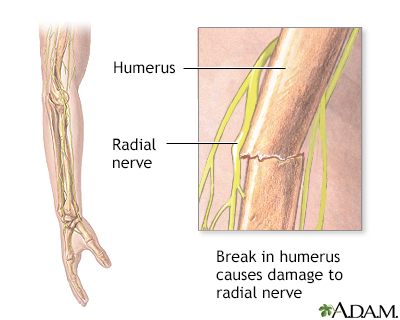Pregnancy SmartSiteTM
Neuropathy - radial nerve; Radial nerve palsy; Mononeuropathy DefinitionRadial nerve dysfunction is a problem with the radial nerve. This is the nerve that travels from the armpit down the back of the arm to the hand. It helps you move your arm, wrist, and hand. CausesDamage to one nerve, such as the radial nerve, is called mononeuropathy. Mononeuropathy means there is damage to a single nerve. Diseases affecting the entire body (systemic disorders) can also cause isolated nerve damage. Causes of mononeuropathy include:
Radial neuropathy occurs when there is damage to the radial nerve, which travels down the arm and controls:
When damage destroys the nerve covering (myelin sheath) or part of the nerve itself, nerve signaling is slowed or prevented. Damage to the radial nerve can be caused by:
In some cases, no cause can be found. SymptomsSymptoms may include any of the following:
Exams and TestsYour health care provider will examine you and ask about your symptoms and medical history. You may be asked what you were doing before the symptoms started. Tests that may be needed include:
TreatmentThe goal of treatment is to allow you to use the hand and arm as much as possible. Your provider will find and treat the cause, if possible. Sometimes, no treatment is needed and you will get better on your own. If medicines are needed, they may include:
Your provider will likely suggest self-care measures. These may include:
Occupational therapy or counseling to suggest changes in the workplace may be needed. Surgery to relieve pressure on the nerve may help if the symptoms get worse, or if there is proof that part of the nerve is wasting away. Outlook (Prognosis)If the cause of the nerve dysfunction can be found and successfully treated, there is a good chance that you will fully recover. In some cases, there may be partial or complete loss of movement or sensation. Possible ComplicationsComplications may include:
When to Contact a Medical ProfessionalContact your provider if you have an arm injury and develop numbness, tingling, pain, or weakness down the back of the arm and the thumb and your first 2 fingers. PreventionAvoid prolonged pressure on the upper arm. ReferencesCraig A. Neuropathies. In: Cifu DX, ed. Braddom's Physical Medicine and Rehabilitation. 6th ed. Philadelphia, PA: Elsevier; 2021:chap 41. Jobe MT, Martinez SF, Weller WJ. Peripheral nerve injuries. In: Azar FM, Beaty JH, eds. Campbell's Operative Orthopaedics. 14th ed. Philadelphia, PA: Elsevier; 2021:chap 62. Katirji B. Disorders of peripheral nerves. In: Jankovic J, Mazziotta JC, Pomeroy SL, Newman NJ, eds. Bradley and Daroff's Neurology in Clinical Practice. 8th ed. Philadelphia, PA: Elsevier; 2022:chap 106. Patterson JMM, Novak CB, Mackinnon SE. Compression neuropathies. In: Wolfe SW, Pederson WC, Kozin SH, Cohen MS, eds. Green's Operative Hand Surgery. 8th ed. Philadelphia, PA: Elsevier; 2022:chap 28. | |
| |
Review Date: 6/13/2024 Reviewed By: Joseph V. Campellone, MD, Department of Neurology, Cooper Medical School at Rowan University, Camden, NJ. Review provided by VeriMed Healthcare Network. Also reviewed by David C. Dugdale, MD, Medical Director, Brenda Conaway, Editorial Director, and the A.D.A.M. Editorial team. The information provided herein should not be used during any medical emergency or for the diagnosis or treatment of any medical condition. A licensed medical professional should be consulted for diagnosis and treatment of any and all medical conditions. Links to other sites are provided for information only -- they do not constitute endorsements of those other sites. No warranty of any kind, either expressed or implied, is made as to the accuracy, reliability, timeliness, or correctness of any translations made by a third-party service of the information provided herein into any other language. © 1997- A.D.A.M., a business unit of Ebix, Inc. Any duplication or distribution of the information contained herein is strictly prohibited. | |

 Radial nerve dysfu...
Radial nerve dysfu...
